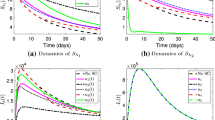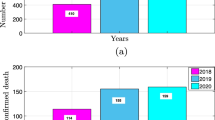Abstract
Lassa fever is a zoonotic viral illness that is endemic in West Africa. The disease has been a subject of intensive research in the mathematics and non-mathematics fields after the first case was confirmed in Nigeria in 1969. Treatment is inevitable after the full incubation of a disease but there may not be a total compliance to treatment guidelines due to factors like poverty and ignorance especially in poor communities. These factors can seriously affect the dynamics of Lassa fever but have not been paid attentions to in the literature. Based on this, a stage of infection when the disease has been fully incubated is considered and a new mathematical model is designed to examine the effect of treatment compliance on the dynamics and control of Lassa fever. The model validity was examined and established using ample mathematics theorems. The equilibria and a threshold for disease eradication were derived. The stability was analyzed and the necessary and sufficient conditions for the equilibria of the model to be stable both locally and globally were derived. Further, sensitivity analysis was carried out to investigate the relative contributions of various parameters to Lassa fever spread and management. Numerical simulation was later conducted via a logical parameter values from the literature to visualize the effect of parameters perturbations on the dynamics of the disease. Results from the study revealed that Lassa fever eradication is a function of total compliance to treatment procedures.


Similar content being viewed by others
Data availability
No data associated in the manuscript.
References
Abdulhami, A., Hussaini, N.: Effects of quarantine on transmission dynamics of Lassa fever. Bayero J. Pure Appl. Sci. 11(2), 397–407 (2018)
Abdullahi, I.N., Anka, A.U., Ghamba, Peter Elisha, P. E., Onukegbe, N. B., Amadu, D. O., Salami, M. O.: Need for preventive and control measures for Lassa fever through the One Health strategic approach. Proc. Singap. Healthc. 29(3), 190–193 (2020). https://doi.org/10.1177/20101058209326
Adewale, S.O., Olopade, I.A., Ajao, S.O., Adeniran, G.A., Oyedemi, O.T.: Mathematical analysis of Lassa fever model with isolation. Asian J. Nat. Appl. Sci. 5(3), 49–57 (2016)
Ajayi, N.A., Nwigwe, C.G., Azuogu, B.N., Onyire, B.N., Nwonwu, E.U., Ogbonnaya, L.U., Onwe, F.I., Ekaete, T., Gunther, S., Ukwaja, K.N.: Containing a Lassa fever epidemic in a resource-limited setting: outbreak description and lessons learned from Abakaliki, Nigeria (January - March 2012). Int. J. Infect. Dis. 17, 1011–1016 (2012)
Ayoade, A.A., Nyerere, N., Ibrahim, M.O.: An epidemic model for control and possible elimination of Lassa fever. Tamkang J. Math. (2023). https://doi.org/10.5556/j.tkjm.55.2024.5031
Akhmetzhanov, A.R., Asai, Y., Nishiura, H.: Quantifying the seasonal drivers of transmission for Lassa fever in Nigeria. Phil. Trans. R. Soc. B 374, 20180268 (2019)
Akinpelu, F.O., Akinwande, R.: Mathematical model for Lassa fever and sensitivity analysis. J. Sci. Eng. Res. 5(6), 1–9 (2018)
Yunus, A.O., Olayiwola, M.O., Omoloye, M.A., Oladapo, A.O.: A fractional order model of Lassa disease using the Laplace-Adomian Decomposition Method. Healthc. Anal. 3, 100167 (2023)
Branco, L.M., Grove, J.N., Geske, F.J.: Lassa virus-like particles displaying all major immuno-logical determinants as a vaccine candidate for Lassa hemorrhagic fever. Virol. J. 7, 279 (2019)
Collins, O.C., Okeke, J.E.: Analysis and control measures for Lassa fever model under socio-economic conditions. J. Phys. Conf. Ser. 1734, 012049 (2021). https://doi.org/10.1088/1742-6596/1734/1/012049
Tahmo, N.B., Wirsiy, F.S., Brett-Major, D.M.: Modeling the Lassa fever outbreak synchronously occurring with cholera and COVID- 19 outbreaks in Nigeria 2021: A threat to Global Health Security. PLOS Glob. Public Health 3(5), e0001814 (2023). https://doi.org/10.1371/journal.pgph.0001814
Favour, A.O., Anya, O.A.: Mathematical model for Lassa fever transmission and control. Math. Comput. Sci. 5(6), 110–118 (2020)
Iacono, G.L., Cunningham, A.A., Fichet-Calvet, E., Garry, R.F., Grant, D.S., Khan, S.H., Webb, C.T.: Using modeling to disentangle the relative contributions of zoonotic and anthroponotic transmission: the case of Lassa fever. PLoS Neglect. Trop. Dis. 9, e3398 (2015)
Ibrahim, M.A., Denes, A.: A mathematical model for Lassa fever transmission dynamics in seasonal environment with a view to the 2017–20 epidemic in Nigeria. Nonlinear Anal. Real World Appl. 60, 103310 (2021)
Idisi, O.I., Yusuf, T.T.: A mathematical model for Lassa fever transmission dynamics with impacts of control measures: analysis and simulation. Eur. J. Math. Stat. 2(2), 19–28 (2021)
Ilori, E.A., Furuse, Y., Ipadeola, O.B., Dan-Nwafor, C.C., Abubakar, A., Womi-Eteng, O.E., Ayodeji, O.: Epidemiologic and clinical features of Lassa fever outbreak in Nigeria, January 1-May 6, 2018. Emerg. Infect. Dis. 25, 1066–1074 (2018)
Lukashevich, I.S.: The search for animal models for Lassa fever vaccine development. Expert Rev. Vaccines 12, 71–86 (2013)
Lukashevich, I.S., Pushko, P.: Vaccine platforms to control Lassa fever. Expert Rev. Vaccines 15, 1135–1150 (2016)
Marien, J., Borremans, B., Kourouma, J., Baforday, J., Rieger, T., Gunther, S., Magassouba, N., Leirs, H., FichetCalvet, E.: Evaluation of rodent control to fight Lassa fever based on field data and mathematical modelling. Emerg. Microb. Infect. 8, 640–649 (2019)
Musa, S.S., Zhao, S., Gao, D., Lin, Q., Chowell, G., He, D.: Mechanistic modeling of the large-scale Lassa fever epidemics in Nigeria from 2016 to 2019. J. Theor. Biol. (2019). https://doi.org/10.1016/j.jtbi.2020.110209
Nwasuka, S.C., Nwachukwu, I.E., Nwachukwu, P.C.: Mathematical model of the transmission dynamics of Lassa fever with separation of infected individual and treatment as control measures. J Adv. Math. Comput. Sci. 32(6), 1–15 (2019)
Obabiyi, O.S., Onifade, A.A.: Mathematical model for Lassa fever transmission dynamics with variable human and reservoir population. Int. J. Differ. Equ. Appl. 16(1), 67–91 (2017)
Okoroiwu, H.U., Lopez-Munoz, F., Povedano-Montero, F.J.: Bibliometric analysis of global Lassa fever research (1970–2017): a 47-year study. BMC Infect. Dis. 18, 639–651 (2018)
Onah, I.S., Collins, O.C., Madueme, P.G.U., Mbah, G.C.E.: Dynamical system analysis and Optimal control measures of Lassa fever disease model. Int. J. Math. Math. Sci. 2020, 7923125 (2020). https://doi.org/10.1155/2020/7923125
Onuorah, M.O., Akinwande, N.I., Nasir, M.O., Ojo, M.S.: Sensitivity analysis of Lassa fever model. Int. J. Math. Stat. Stud. 4(1), 30–49 (2016)
Roberts, L.: Nigeria hit by unprecedented Lassa fever outbreak. Science 359, 1201–1202 (2018)
Sattler, R. A., SPaessler, S., Ly, H., Huang, C.: Animal models of Lassa fever. Pathogens 9, 197 (2020) https://doi.org/10.3390/pathogens9030197
Usman, S., Adamu, I.I.: Modelling the transmission dynamics of Lassa fever infection. Math. Theory Modell. 8(15), 42–63 (2018)
Warner, B.M., Safronetz, D., Stein, D.R.: Current research for a vaccine against Lassa hemorrhagic fever virus. Drug Des. Dev. Therapy 12, 2519–2527 (2018)
Zhao, S., Musa, S.S., Fu, H., He, D., Qin, J.: Large-scale Lassa fever outbreaks in Nigeria: quantifying the association between disease reproduction number and local rainfall. Epidemiol. Infect. 148, e4 (2020). https://doi.org/10.1017/S0950268819002267
Birkhorff, G., Rota, G.C.: Ordinary Differential Equations. Needham Heights, Ginn, Boston (1982)
Diekmann, O., Heesterbeek, J.A.P., Metz, J.A.J.: On the definition and computation of the basic reproduction ratio in models for infectious diseases in heterogeneous populations. J. Math. Biol. 28, 365–382 (1990)
Driessche, P.V.D., Wathmough, J.: Reproduction number and sub-threshold endemic equilibria for compartmental models of disease transmission. Math. Biosci. 180, 29–48 (2002)
Castillo-Chavez, C., Song, B.: Dynamical models of tuberculosis and their applications. Math. Biosci. Eng. 1, 361–404 (2004)
Lakshmikantham, V., Leela, S., Martynyuk, A.A.: Stability Analysis of Nonlinear Systems. Marcel Dekker Inc, New York and Bassel (1989)
Ayoade, A.A., Ibrahim, M.O.: Analysis of transmission dynamics and mitigation success of COVID-19 in Nigeria: An insight from a mathematical model. The Aligarh Bulletin of Mathematics 41(1), 81–106 (2022)
Adenuga, J.I., Ajide, K.B., Odeleye, A.T., Ayoade, A.A.: Abundant natural resources, ethnic diversity and inclusive growth in sub-Saharan Africa: a mathematical approach. Appl. Appl. Math. Int. J. (AAM) 16(2), 1221–1247 (2021)
Hugo, A., Simanjilo, E.: Analysis of an eco-epidemiological model under optimal control measures for infected prey. Appl. Appl. Math. Int. J. 14(1), 117–138 (2019)
LaSalle, J.P.: Stability theory for ordinary differential equations. J. Differ. Equ. 4, 57–65 (1968)
LaSalle, J.P., Lefschetz, S.: Stability by Liapunov’s Direct Method with Applications. Academic Press, New York (1961)
Ayoade, A.A., Ibrahim, M.O.: Modeling the dynamics and control of rabies in dog population within and around Lagos, Nigeria. Eur. Phys. J. Plus 138, 397 (2023)
Varrela, S.: Life expectancy at birth in Nigeria 2021, by genders. Available at https://www.statista.com/statistics/1122851/life-expectancy-in-nigeria-by-gender/ [Accessed 5 Feb 2021] (2021)
Ojo, M.M., Gbadamosi, B., Benson, T.O., Adebimpe, O., Georgina, A.L.: Modeling the dynamics of Lassa fever in Nigeria. J. Egypt. Math. Soc. 29, 1–19 (2021)
Nigeria Centre for Disease Control (NCDC). (2018). Nigeria Centre for Disease Control Handbook, Accessed July 29, 2020 from http://www.ncdc.gov.ng (2020)
Thota, S., Ayoade, A.A.: On dynamical analysis of prey-diseased predator model with refuge in prey. Appl. Math. Inf. Sci. 15(6), 717–721 (2021). https://doi.org/10.18576/amis/150605
Thota, S.: A three species ecological model with Holling Type-II functional response. Inf. Sci. Lett. 10(3), 439–444 (2021). https://doi.org/10.18576/isl/100307
Thota, S.: On an ecological model of mutualisim between two species with a mortal pVol. redator. Appl. Appl. Math. 15(2), 1309–1322 (2020)
Author information
Authors and Affiliations
Corresponding author
Ethics declarations
Confict of interest
The authors declare no conflict of interest.
Consent to Participate
Not applicable.
Consent for Publication
Not applicable.
Ethical approval
No ethics approval was required.
Additional information
Publisher's Note
Springer Nature remains neutral with regard to jurisdictional claims in published maps and institutional affiliations.
Rights and permissions
Springer Nature or its licensor (e.g. a society or other partner) holds exclusive rights to this article under a publishing agreement with the author(s) or other rightsholder(s); author self-archiving of the accepted manuscript version of this article is solely governed by the terms of such publishing agreement and applicable law.
About this article
Cite this article
Ayoade, A.A., Aliu, O. & Taiye, O. The effect of treatment compliance on the dynamics and control of Lassa fever: an insight from mathematical modeling. SeMA (2024). https://doi.org/10.1007/s40324-024-00353-9
Received:
Accepted:
Published:
DOI: https://doi.org/10.1007/s40324-024-00353-9




